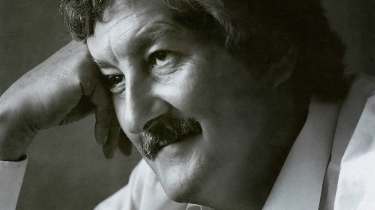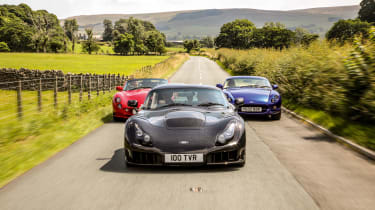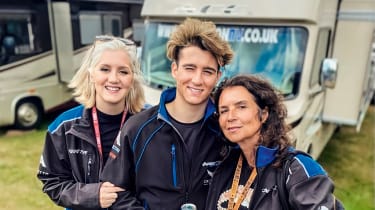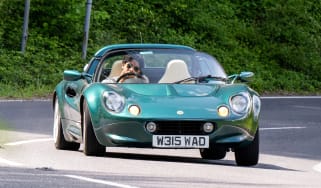Life after TVR's Peter Wheeler
He was the man who transformed TVR from cottage car-maker into one of the world’s great sports car marques. We chat to Peter Wheeler’s family about his legacy and redeveloping the old factory site
Drive up Bristol Avenue in Blackpool today and you won’t find much left of the place where Peter Wheeler and his team of mostly young, enthusiastic engineers and designers conceived, developed and built cars like the Griffith, Cerbera and Sagaris. Instead you’ll find the works being replaced by rows of neat, new industrial units catering for a range of small businesses.
The development is called The Wheeler Hub and in a year or two it could become a destination for TVR and sports car fans generally once more because at its heart will be a life-size statue of 6ft 6in Peter Wheeler and his beloved dog, Ned.
> TVR breaks its silence – Griffith now scheduled for 2023
The TVR works in Bristol Avenue was never a particularly handsome place, looking more like a factory making something mundane like kitchen equipment – probably because before it became the home of TVR Engineering in the early ’70s that’s exactly what it did. It looked vastly more attractive with sports cars crowding the parking spaces out front, particularly during the successful Wheeler era.
When Wheeler sold TVR Engineering to the young Russian Nikolai Smolenski in 2004, the deal didn’t include the Bristol Avenue factory; Wheeler leased it to him. After TVR went into receivership in late 2006 the buildings were rented to a variety of businesses.
‘A lot of the people that worked at TVR took on units and made their own businesses there,’ says Wheeler’s widow, Vicky Oyston (née Wheeler). ‘Peter’s mechanic still has his business there and up until recently there was a company doing chassis frames and bodywork, so TVR has never quite left the place.’
The statue of Peter and Ned, commissioned by Vicky, has been designed by Graham Browne, TVR’s chief designer from ’98 to 2005, and the drawings are now with Rotherham-based DNA Metalwork. The forms of Peter and Ned will be cut from 10mm thick ‘weathering steel’ on a state-of-the-art fibre-laser machine, the latest in intricate and clean cutting technology. Over time, exposed to the elements, the steel will gain an orange, oxidised surface finish just like Antony Gormley’s massive artwork Angel of the North, which overlooks the A1 at Gateshead.
‘As the statue is going in the middle of the site,
it will be a while before we put it in place,’ says Vicky. Work has just started on phase two. The roads around will have evocative names, too; there’s already a Tuscan Way and other Wheeler-era models will get name-checked in the finished development, which will cover the entirety of the former TVR factory site.
Bristol Avenue is a part of Vicky’s heritage, too. She joined TVR in 1994, initially working with Ben Samuelson on the PR side. ‘No-one had a job title as such, we filled in wherever needed, so I started looking after the Tuscan race weekends with Ben as well. Then, further along the line, I ended up as Peter’s PA.’ They later married and had three children together.
After Peter’s death in 2009, Vicky ensured his last projects were completed: the amphibious Scamander and the 5000M that had been built for him by ex-TVR employees for historic racing. ‘We still have Peter’s Tuscan Challenge racer, number eight, and the 5000M,’ says Vicky. ‘Joe is desperate to get out in that somewhere!’
Joe, 17, is the youngest of the offspring and last year competed in the ultra-competitive Ginetta Juniors race series, finishing in the top ten and earning the accolade of ‘top overtaker’ having gained an impressive 96 places over the season.
Next year he’s moving up to Ginetta GT4s, running alongside Freddie Tomlinson, son of Ginetta boss Lawrence Tomlinson.
Joe is fully aware of his father’s legacy, partly because since the age of five he has owned one of the best cars created by the company: the black Sagaris in the picture on the right. On a summer’s day back in 2010 he went with his sisters and mum to a local TVR dealership to choose a car. Flanking Joe’s Sagaris are the Tuscan chosen by Elizabeth (24) and the Cerbera chosen by Anne (22).
‘It was the year after Peter passed. Obviously, everything had been difficult,’ says Vicky, ‘but I took them along to Hexham Horseless Carriages and let them choose, so that they’d have something to remember Peter by. And they remember going and they remember choosing the cars.’
‘Yeah, I remember,’ says Joe. ‘Mum wouldn’t tell me what we were going to do, so it was a big shock when I got there. I was so young at the time, I had no idea. It was quite a strange experience. I think I chose the Sagaris because, looking at all of them, it’s the most crazy, childish one, isn’t it? I’m quite happy with my choice!’
Joe’s not the only chip off the old block, though, as Vicky explains. ‘Elizabeth went into engineering like Peter and is doing a PhD in biomedical engineering at Imperial College London. Annie would like to do some rallying but she’s been so busy; she’s just finished her degree and is about to start her master’s in biomedicine at Manchester Uni, but is still aspiring to rally in the future. She regularly comes to the racing and if she had time in her life, I think she’d start rallying.’
While his sisters are now old enough to be insured to drive their TVRs on the road, so far Joe – who is doing his A-levels alongside his racing – has only been able to drive his Sagaris up and down a few private roads on the family estate. This is despite passing his test first time (after just one lesson, on the day before the test) and now having three seasons of racing behind him. ‘He’s been driving stuff around the estate since he could walk,’ says Vicky.
‘It’s quite weird,’ says Joe, ‘I only started talking when I was about five – I think my sisters did the talking for me! – so I was actually driving before I could construct a sentence!’ His first season was in a Citroën Saxo in the JSCC – the Junior Saloon Car Championship – when he was 15. But when he moved into Ginetta Juniors he didn’t appreciate how competitive it would be.
The series is part of the British Touring Car Championship package and gets live race coverage on ITV4, giving it a serious profile. He discovered that most of his rivals had been karting since they could walk and some had gone as far as learning to drive the Ginetta Junior for up to 18 months before entering their first race.
‘The first 20 are usually covered by a second in qualifying,’ says Joe. ‘Everything you can think of counts. The level that the series is at right now is crazy. The cars are quite hard to drive; speaking to people who’ve done it and moved into Porsches, they say it’s one of the hardest championships.’
The unique 5000M that Joe is keen to exercise can claim to be the last TVR built in the Bristol Avenue works. When the factory was first converted into industrial units, Wheeler trusted three ex-TVR employees with their business there to build the 5000M, his last race car.
With its 400bhp, 4.7-litre Ford V8, it gave Wheeler exactly the sort of car that suited his driving style, which he once described as ‘applying copious amounts of power along the straights, braking early, letting everyone catch up and then disappearing again on the next straight’! Quite a contrast with Ginetta Juniors, which are all about slipstreaming and preservation of momentum, but if Joe has his way it won’t be long before we see the Wheeler name next to a TVR on an entry list again.
This story was first featured in issue 294.











